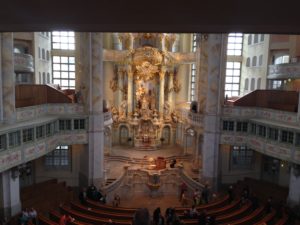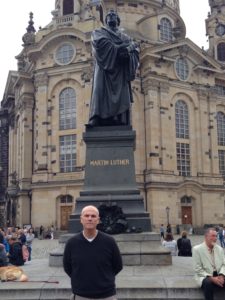On October 31, 1517, a German monk named Martin Luther posted on a church door a list of 95 issues he thought the Roman Catholic church should address.
That act, just short of 500 years ago, led to the Protestant Reformation — an event which changed Europe irrevocably and next month will be observed in several parts of the continent and North America.
Luther lived and worked largely in the German state of Saxony, and the capital of Saxony is Dresden — barely a two-hour bus ride from Prague.
Dresden has some remarkable history of its own, some of it relating to the Lutheran church, in which I was raised.
That is why I made a point of making the journey north to see one of the best-known Lutheran churches which, along with the city, rose from the ashes of one of the most destructive bombing raids of World War II.
The war in Europe was nearly over, on February 13, 1945, when hundreds of British planes firebombed Dresden, a city some historians claim was of marginal military significance, killing an estimated 25,000 people.
(The American POW and future author Kurt Vonnegut was in Dresden for the firebombing, and most Americans aware of the attack came to know it through Vonnegut’s novel Slaughterhouse-Five.)
What made the bombing attack particularly horrifying and memorable were the fires created in the old, wooden part of town, which turned into a firestorm with temperatures at its center of 2,000 degrees Celsius.
The old center of the city was burned to the ground, including the imposing Baroque church known as the Frauenkirche, a Lutheran church as well as an architectural and visual marvel built in the 1700s.
The distinctive dome of the church survived the bombing, but it did not hold up to the enormous heat, and ultimately collapsed.
For the next 20 years, the church rubble was left untouched in Dresden by the Soviet Union’s puppet East German government, an act of neglect allegedly meant as a reminder of the horrors of war but perhaps also as a mute warning to East Germans about rising against their Soviet masters.
After the collapse of the Soviet Union, in 1990, and the reunification of Germany, a decision was made by the state and federal authorities to rebuild the Frauenkirche, making it as much like the original church as possible. Many of the original stones were salvaged and used in the new church. By 2005 it was completed and reconsecrated as an Evangelische (Lutheran) church.
It is a remarkable building, with a nearly round nave, which is nearly vertical and contains four levels of seating.
Much of the interior is in pastel colors; light cascades threw the sanctuary. The altar area is unusually ornate for a Lutheran church.
The members of the church are unusually active. The Frauenkirche not only is a tourist attraction with a great backstory, it stages numerous musical events, as well as divine worship each Sunday at 11 a.m. That is the event I attended, following along as best I could with my half-remembered school German.
The service included a long organ prelude and music from the oboe, flute, trumpet, violin, viola and cello.
It was a great reminder of all things Lutheran in this especially important year on the church calendar. I will not be at the Frauenkirche (or in Germany at all), when the 500th anniversary of Luther’s daring criticisms of 1517 are celebrated, but I got a head start.
Oh, and one more bit, about Luther.
In the 1800s, a bronze statue of the reformer was placed just outside the Frauenkirche, in the middle of the old town square.
Luther’s statue was knocked down, during the bombing, but it did not melt (as can be seen in the third photo here), and it has been put back on its pedestal, with Luther holding a Bible and looking defiant.



0 responses so far ↓
There are no comments yet...Kick things off by filling out the form below.
Leave a Comment